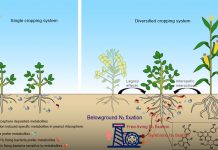土壤富里酸一般认为是土壤有机质中较为活性的腐殖质组分,其含量虽然不高但在土壤腐殖化过程中扮演着重要的角色。封丘的潮土有机质含量低,前期的研究表明缺磷对于提高土壤有机质含量和作物产量都有严重的影响,但目前尚不清楚缺磷条件下富里酸的结构如何响应变化。
为此,我室赵炳梓课题组利用封丘长期试验地平台借助高级核磁共振技术研究了23年长期平衡施肥和缺磷条件下富里酸的结构分异,并以土壤有机质含量较高的桃源水稻土作为对照。结果表明潮土平衡施肥相比缺磷处理均增加了富里酸的分解程度和芳香度,暗示平衡施肥下富里酸的腐殖化程度更加明显;而水稻土富里酸的结构则差异较小,说明两种截然不同的气候环境和土壤中,富里酸结构对施肥的响应也有所区别。利用偶极相移技术研究还发现两种土壤富里酸中的芳香碳非质子化比例达到44-52%,施肥尤其是有机肥降低了该比例。非质子化的芳香碳相对难以被降解,从这个角度看富里酸并没有预期的高活性。研究结果为富里酸结构提供了新的认识,并为提高土壤肥力提供了一定的理论依据。
Xu JS, Zhao BZ, Mao JD, Chu WY, Li DD, Ma L, Zhang JB, Wei WX. Does P-deficiency fertilization alter chemical compositions of fulvic acids? Insights from long-term field studies on two contrasting soils: A Fluvisol and an Anthrosol. Soil and Tillage Research, 2018, 178: 189-197
Abstract
Structural changes in fulvic acid (FA) in response to fertilization strategies, especially P-deficiency fertilization, have critical implications for soil carbon dynamics. This study examined how long-term fertilization influenced chemical compositions of soil FA and its humification degree. Advanced solid-state 13C nuclear magnetic resonance techniques were used to evaluate structural changes of FAs from two soils (a Fluvisol and an Anthrosol) under four fertilizer treatments: organic fertilizer combined with or without NPK fertilizer (OF and NPKOF), deficient in phosphorus only (NK) and Control. The greater aromaticity, hydrophobicity and alkyl/O-alkyl (A/O-A) ratios of FAs were observed in the Anthrosol than in the Fluvisol. The Anthrosol FAs contained more alkyl and aromatic C but fewer O-alkyls (mostly being protonated) than did the Fluvisol FAs. Both FAs comprised some nonprotonated aromatics, which decreased with applications of organic and NK fertilizers. This trend was less obvious for the Anthrosol than for the Fluvisol. Organic fertilizer treatments (OF and NPKOF) in the Fluvisol increased the A/O-A ratio and aromaticity compared with P-deficient soils (NK and Control), indicating organic fertilization promoted the humification degree of its FA. The NK treatment in the Fluvisol increased H/C ratio of FA. Compared with the Fluvisol FAs, the Anthrosol FAs displayed similar chemical natures, implying their formation followed similar processes with a similar humification degree. The findings suggest that long-term fertilization differently influenced the FAs from the Fluvisol and Anthrosol. Clearly, the Anthrosol FAs shared more common features among the treatments compared with the Fluvisol FAs, whereas P-deficiency rendered the Fluvisol FAs simpler.










